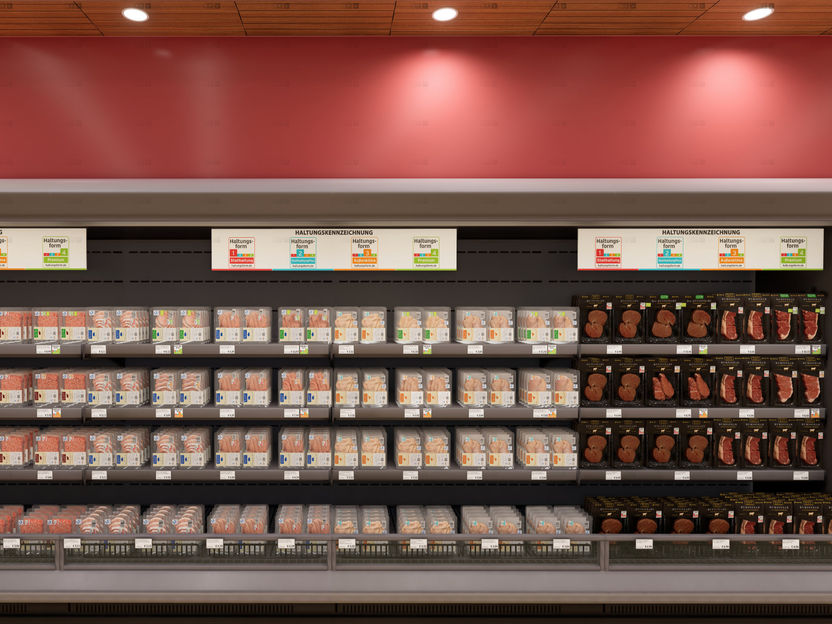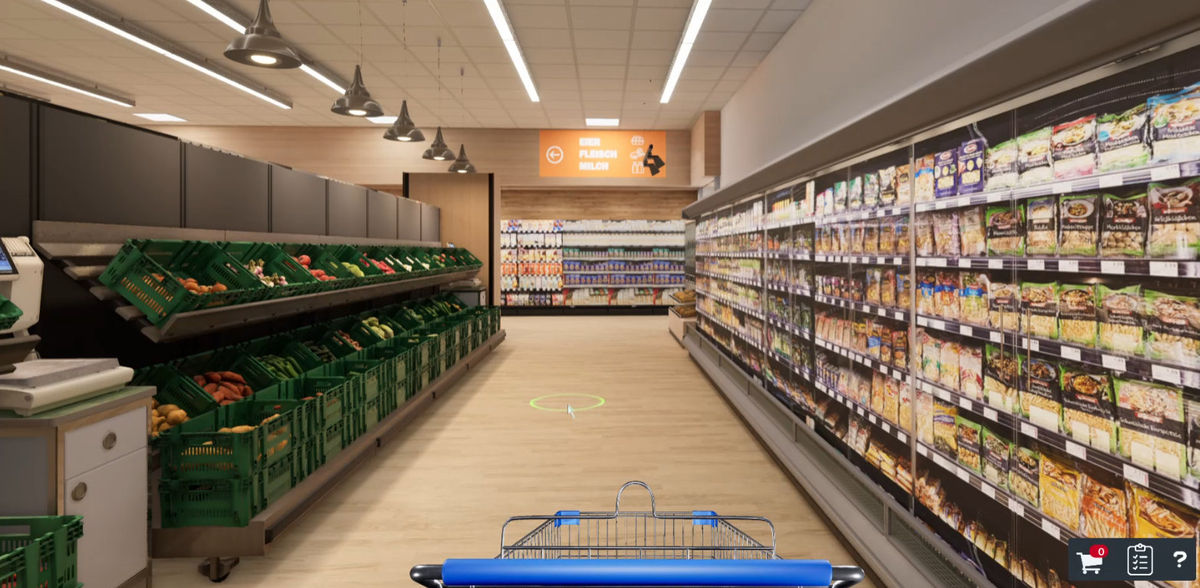Shopping study in a virtual supermarket
Banners with information on animal welfare have no influence on purchasing behavior
Advertisement
How can we encourage consumers to pay more attention to animal welfare aspects when they purchase meat? It now appears that this cannot be achieved solely by making the animal husbandry labels more visible. At least this is what the findings of a study carried out by the University of Bonn and TU Munich tend to indicate. In this study, the researchers invited test subjects to go shopping in a virtual supermarket. However, placing banners and labels indicating the type of animal husbandry on the shelves had no effect on their purchasing decisions. The results have now been published in the Journal of Consumer Protection and Food Safety.

Large banners with the husbandry labels were displayed for one group of participants.
ILR/Uni Bonn
We are all familiar with the red, blue, orange, or green labels that have been displayed on meat packaging for several years. These labels provide information on the type of animal husbandry used to raise the relevant animal. Red (= animal husbandry level 1) means that the producer only complies with the minimum statutory requirements. In contrast, green (= animal husbandry level 4) means that the producer complies with much higher standards concerning the welfare of the animals. “However, this type of information is often not consciously noticed by customers,” says Leonie Bach from the Institute for Food and Resource Economics at the University of Bonn.
The young researcher is a PhD student at the Department of Agricultural and Food Market Research headed by Prof. Dr. Monika Hartmann and was one of the main researchers behind this latest study. The study carried out by researchers at the University of Bonn and TU Munich investigated whether it is possible to improve the effectiveness of animal husbandry labelling by making it more visible.
Virtual supermarket
Instead of using a real grocery store to investigate these measures, the researchers carried out their study in a virtual supermarket. This innovative approach has several advantages: As the purchases are made on a computer, it was comparatively easy to find a large number of test subjects to participate in the study. Another advantage is that – aside from the particular measure being tested – the supermarket looked identical to all of the test subjects. This means that their shopping behavior was not influenced by any hidden factors. “By using a virtual supermarket as our research infrastructure, we were able to bring the real world into the laboratory,” explains Prof. Dr. Monika Hartmann.
In the experiment, a total of 630 participants were asked to push their shopping cart through the digital aisles, which recreated the look and feel of a real supermarket. “We developed the 3D simulation in cooperation with the market research institute IPSOS,” explains Bach. The graphics were based on modern video games: The test subjects saw the aisles from a first-person perspective and were able to turn and face the supermarket shelves, pick up and examine the products from all sides, place them in their shopping cart and finally purchase them at the end. However, the purchasing decision was only hypothetical – the participants did not pay for their virtual shopping and no real goods were delivered to them afterwards. In follow-up interviews, the majority of the participants indicated that they had found the simulation to be very realistic and were able to use it without any difficulties.
Three versions of the same supermarket
IPSOS sent out emails to invite the participants to take part in the study. The type of supermarket displayed to them in the simulation only differed in one aspect: the manner in which information on animal husbandry was emphasized. One group of participants only saw the labels on the meat packaging as is typical in supermarkets today. A second group were additionally shown large banners over the shelves with information on the animal husbandry label. These labels were also displayed next to the price tags for a third group of participants, although only for products in animal husbandry levels 3 and 4.
The sobering results: There was no real difference between the three groups in the number of test subjects who selected meat produced according to better animal welfare standards. In other words, the measures did not cause any change in their purchasing behavior. “One reason for this result could be that the information did not generate the desired level of awareness, despite it being displayed prominently in the supermarket,” suspects Leonie Bach. “Some of our test subjects indicated in the follow-up interviews that they had not consciously noticed or perceived the information.”
“We are currently evaluating other interventions that we have already tested in the virtual supermarket,” explains Prof. Dr. Monika Hartmann. In future projects, the authors of the study would like to make the purchasing experience even more real for participants so that they receive the purchased products in a similar way to online shopping and also have to pay for them.
Original publication
Leonie Bach, Nina Weingarten, Kathrin Barbara Meyer, Ching-Hua Yeh, Irina Dolgopolova, Wen-Xiu Wang, Jutta Roosen, Monika Hartmann; "Der virtuelle Supermarkt als innovative Forschungsinfrastruktur: Experiment zur Erhöhung der Salienz für Fleischprodukte mit höherem Haltungsstandard, The virtual supermarket as an innovative research infrastructure: experiment to increase the salience for meat products with a higher husbandry standard"; Journal of Consumer Protection and Food Safety, 2024-3-12
























































